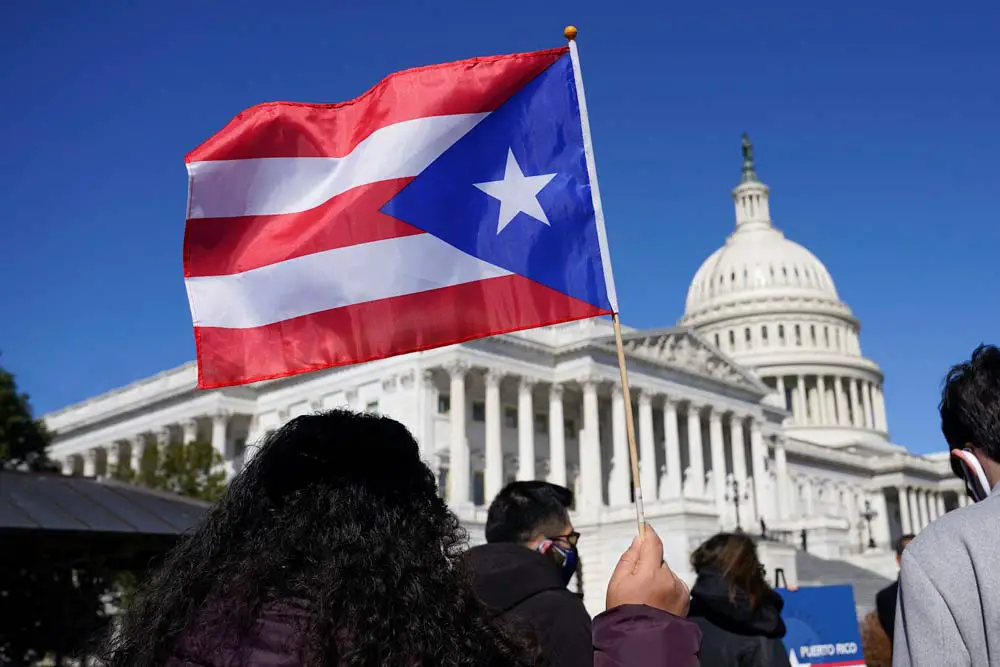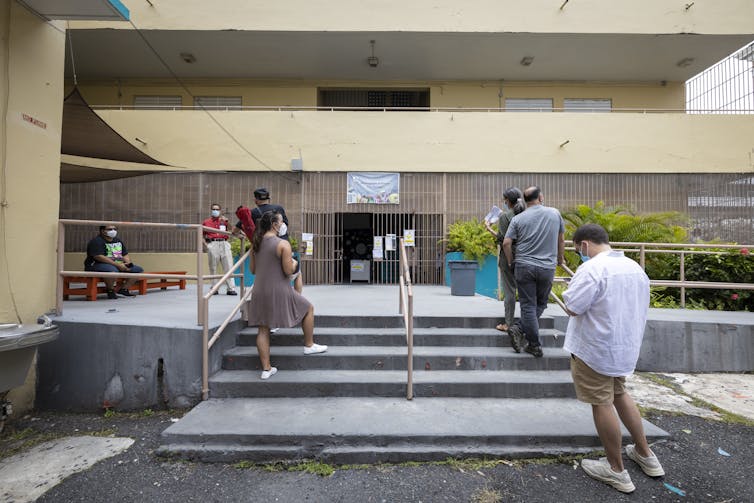
By Jorge Duany
In the 125 years since U.S. troops invaded Puerto Rico on July 25, 1898, during the Spanish-American War, the U.S. government has controlled the island militarily, politically and economically – with no end in sight or, for Puerto Rico, a clear path to statehood.
That has been an issue of contention for many Puerto Ricans living on the island and stateside.
As I have documented in my 2017 book “Puerto Rico: What Everyone Needs to Know,” the island of nearly 3.3 million people has a peculiar position in Latin American and Caribbean countries because of its dependent relationship with the U.S.
Technically, Puerto Rico is an “unincorporated territory” that legally belongs to but is not a part of the United States.
The road to territorial dependence
In a case about the constitutionality of a tariff on goods trafficked between the island and the mainland, the U.S. Supreme Court defined Puerto Rico in 1901 as “foreign to the United States in a domestic sense” because it was neither a state of the American union nor an independent republic.
The court also ruled that the island was “a territory belonging to … but not a part of the United States.”
This decision meant that Congress would determine which parts of the U.S. Constitution applied to Puerto Rico.
In another case, the court declared in 1904 that Puerto Rican emigrants to the U.S. were not “aliens” and could move freely to the U.S. mainland.
Congress granted U.S. citizenship to all residents of Puerto Rico in 1917, but it did not extend to them all constitutional rights and obligations of citizenship, such as having congressional representation or paying federal income taxes.
In 1952, Puerto Rico became a U.S. commonwealth (or “Estado Libre Asociado” in Spanish) with a greater degree of autonomy than it previously had.
A colony except in name
As the U.S. and Puerto Rico mark the anniversary of the invasion on July 25, 2023, the island maintains a status similar to a colony because it lacks sovereignty and full representation in the federal government.
Like the District of Columbia and other territories such as Guam and the U.S. Virgin Islands, Puerto Rico elects a delegate – called a resident commissioner in Puerto Rico’s case – to the House of Representatives. But that delegate can only vote in congressional committees, not in full floor votes.
And Puerto Ricans living on the island cannot vote for the U.S. president and vice president.
But the president and Congress can determine policies about domestic programs, defense, international relations, foreign trade, and investment that affect people living in Puerto Rico. In the past, for instance, Congress has excluded or limited Puerto Ricans from access to federally funded programs such as Medicare, Supplemental Security Income and the Supplemental Nutrition Assistance Program.
The island’s colonial status became an even greater issue during the past decade.
In June 2015, then-Governor Alejandro García Padilla declared that Puerto Rico’s public debt of over US$72 billion was “not payable.”
But because Puerto Rico is not a state, it does not qualify for federal bankruptcy. In order to restructure the debt, Congress passed the Puerto Rico Oversight, Management, and Economic Stability Act in June 2016, which placed the island’s fiscal affairs under direct federal control.
In August 2016, then-President Barack Obama appointed a seven-member oversight board from a list of candidates nominated by Congress, including four Puerto Ricans.
This board, derisively called “la junta” by Puerto Ricans, is strangely reminiscent of the Executive Council, which ruled the island between 1900 and 1917 with little input from local elected officials.
The board will remain in effect until Puerto Rico has balanced its budget.
Statehood for Puerto Rico?
Puerto Rico has held six referendums about its political status since the 1960s.
Most voters rejected a status change in 1967, 1993 and 1998.
The 2012 results were unclear because many voters did not answer both parts of a two-part status question.
In 2017, statehood won decisively – over 97% of those who participated – but the turnout was very low at 23%.
In the most recent 2020 vote, almost 53% of the voters supported becoming the 51st state of the American union. But nearly half of the electorate rejected this option, underscoring the split among Puerto Rican voters.

Alejandro Granadillo/Anadolu Agency via Getty Images
In December 2022, the House of Representatives passed H.R. 8393, proposing yet another referendum on Puerto Rico’s political status, which would have been the first to bind Congress to implement its results. But the Senate failed to consider the bill.
As it is now, only Congress can add new states to the Union, via an Admission Act or House Resolution that requires approval by a simple majority in the House and Senate.
Another bill – the Puerto Rico Status Act or (H.R. 2757) – was introduced in May 2023, but given the lack of congressional bipartisanship, it is unlikely that the bill will obtain enough Republican votes in the Senate.
As a result, 125 years after the U.S. occupation, Puerto Rico is still considered “foreign in a domestic sense.”
![]()
Jorge Duany is Professor of Anthropology and Director of Cuban Research Institute at Florida International University.






























Ray W. says
Regarding those EV naysayers who contrive controversy about the effectiveness of EV’s, Nio, a Chinese automaker that does not express current plans to export to the U.S., reports that it plans to begin selling EV’s in its domestic marketplace later this month that have a solid-state battery pack, a world-wide first.
I concede that what I am relaying to FlaglerLive readers may not turn out to be fully accurate, corporate claims being what they are, but Nio claims to have designed the new version of its battery pack to interchange with its previously sold liquid-state lithium-ion batteries, so owners of older model Nio EV’s can upgrade by installing the newer-style solid-state batteries.
The new pack, according to Nio, provides 578 miles of range, as opposed to roughly 300 miles for its older-style batteries, with a weight cost of only 20 more kilos. Energy density, the overall goal of battery technology (storable energy per kilogram), is 45% greater with the solid-state system, compared to liquid-state technology.
The solid-state batteries recharge faster, discharge faster, and can be recharged up to 10,000 times before overall capacity begins to drop off, as compared to the 2000 to 3000 recharge limits for liquid-state batteries. Toyota claims that its solid-state battery system, in current development and with an expected release date in 2027 or 2028, will have a recharge time of 10 minutes.
The manufacturing carbon footprint is reportedly nearly 40% less than a comparable liquid-state battery.
From a safety perspective, solid-state battery packs are far less vulnerable to fires that occur in collisions or due to faulty manufacturing, as the solid lithium metal plate in this type of battery is not combustible.
We just might be seeing a revolution in battery technology, with more to come. Many American companies are developing solid-state battery technology. I recently wrote of GM’s plan to invest $5 billion in a joint venture to build a domestic solid-state battery manufacturing plant.
Simple mathematics of 10,000 recharges with a range of 578 miles yields a battery lifespan of more than 5 million miles before battery efficiency begins to drop off, so recycling issues will be dramatically reduced.
Yes, I concede that rapid recharging systems shorten long-term battery life, but with a range of nearly 600 miles, very few daily commuters will need access to a rapid recharge point. A regular home-based 220-volt system should suffice for nearly all applications.
I remember seeing a short documentary on a European city bus recharging station. The driver pulled the bus into a curbside charging station and a robotic arm automatically moved to the correct location and lowered its charger onto the bus without the driver doing anything but park the bus close enough to the charging arm. According to the documentary’s commentary, bus drivers get a 15-minute break every 90 minutes, which was enough time to keep the bus fully charged. In time, I could only hope for home robotic recharging stations. Park the car in the garage and enter the home. The robotic system will do the rest.
In sum, a more reliable, safer, more energy dense, faster charging and discharging, longer lasting and less pollutive battery system just may be one of many coming solutions to our transportation needs. After decades of reading about promising new battery breakthroughs that never came to pass, this one seems to be based on realizable goals.
Ray W. says
Somehow, this comment is attached to the wrong article. Probably my flying fingers. Oh, well!
TR says
What in the world does your pushing electric vehicles have to do with Puerto Rico being part of the USA??
Ray W. says
You are, of course, correct to wonder why the article was erroneously attached to this article. One possible explanation is that I commonly write a comment and walk away from it for a time, just to let it gel a little more in my mind. Perhaps, I walked away and then clicked on a new article to read it. The comment remained unsent and when I returned to it and clicked on it, it was attached to the wrong article. Maybe that is not what happened.
You are, of course, partially wrong in asserting that I am “pushing” electric vehicles.
I have stated several times that Adam Smith’s important work on An Inquiry into the Nature and Causes of the Wealth of Nations is to me more of an explanation of his perception of human economic behavior, as opposed to being an economic theory in the sense of a scientifically reliable and provable argument. I assert again that I interpret him as arguing that the invisible hand of the marketplace requires that we all act in our perceived selfish best interest. If that is an accurate interpretation of his ideas, I will always push for what I selfishly perceive as the most efficient form of transportation currently available to us all. In this case, I focused on solid-state battery technology, which has many potential non-transportation applications, as well as transportation issues.
Since the announcement by Nio involves transportation, I framed my comment in the context of transportation. If it had been a new home battery storage system, I would have framed it in that context, but weight and size are not really issues in home battery storage; it is of great importance in vehicle design.
If we were to develop a much more efficient form of hydrogen powered vehicles, I would comment on that, too. If an automaker developed a line of diesel-powered vehicles that operate with a 90% natural gas and 10% diesel fuel mixture, I would report on that, too.
I have commented about train companies experimenting with 90% natural gas/10% diesel fuel locomotives, but the logistics of developing large liquified natural gas railcars to allow for long-range cargo transport limits that possibility. I have focused on current experiments by heavy power companies to introduce the use of hydrogen into a mixture in the combined cycle natural gas turbine electrical generating plants already operating in the U.S., with experiments using a 30% hydrogen mixture offering positive initial results.
I framed my initial comment in the perspective of an intellectually curious observer. I am not using the internet to engage in “research”, as I believe that that term is too often misused by various commenters. To me, I “review” other people’s research. I that sense, I am not performing my own research. Review may simply be a more accurate term.
Intellectual curiosity has always, to me, been a virtue worthy of developing, perhaps in the hope that I will become less and less gullible. So many FlaglerLive commenters present as gullible people, in the sense that they create credulity for people and sources who do not deserve that credulity, either because the people or sources do not know what they are talking about or because they are intentionally offering misleading or false information in hopes of taking advantage of the gullible among us.
Steven says
It would take a thousand pages to give the real story. The first omission was that Puerto Ricans living in New York City went to Washington to lobby for American troops to attack Puerto Rico and kick the Spanish out. Because the Americans were only going to fight in Cuba. And when they did invade, the locals were ecstatic to see them and to kick the hated Spanish out. Nobody ever mentions thst.
J. Mercado says
None of Dunay’s claims are true. Puerto Ricans who live on the island do not see the USA as an abuser using them unfairly. Don’t believe me? Just check the plebiscitary statistics for the past 71 years. About 98% of islanders have consistently voted in favor of staying associated with the United States, plebiscite after plebiscite, referendum after referendum. And none of it is a Stockholm Syndrome.
Pierre Tristam says
The more relevant vote is about statehood.